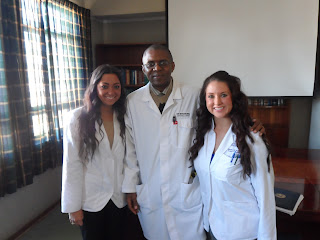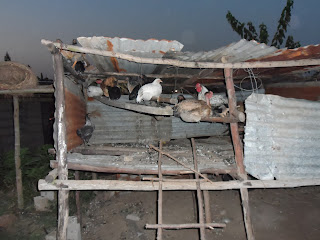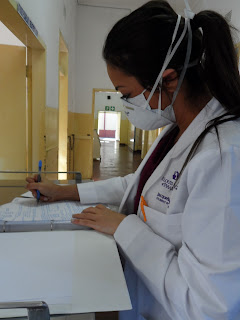We felt that it was very important to go through the roles of each member of the health care team in attempts to focus on the importance of collaboration. We discussed differences and similarities between the two countries, especially in regard to education. For example, pharmacy technicians in Swaziland are much more educated than pharmacy technicians in the USA. They go through about 2 years of school and have a much bigger role in medication delivery and patient monitoring.
We discussed the two pharmacy practice models including the drug-distribution centered model as well as the patient-centered integrated model. The health care team at RFM hospital was particularly interested in the advanced technology we use in the USA including the Pyxis machine, bar code medication administration, and electronic prescription processing.
The biggest difference in pharmacy between Swaziland in the US is prescription processing. In the USA, prescriptions are reviewed several times by the pharmacist and technicians work under their direct supervision. In Swaziland, a pharmacist is not required to be present for a medication to be dispensed and they do not have as many checks and balances as we do in the US.
Example of prescription processing in the USA
Next, we discussed the importance of patient counseling and education. We believe this is especially important in Swaziland with the low levels of education and access to resources. The majority of the population is very poor and cannot afford a good education leading to low reading levels and health literacy. Further, many people live in rural communities and do not have good access to hospitals or health care clinics. This is why it is so important to educate every single patient when they come to RFM. We explained verbal and non-verbal communication and how to effectively use the teach-back method in a patient counseling session. Finally, we explained our unit-dose distribution system and compared it to their floor stock system. We explained that the floor stock system was a model we used previously and how we evolved to our current unit-dose model. We finished our presentation by again stressing the importance of collaboration and how it can improve health outcomes.
We were very thankful for the members of the RFM team who took time out of their busy day to see our presentation. They were very attentive and seemed very interested in health care in the US. This presentation allowed us not only to suggest improvements in Swazi health care delivery, but also to identify the flaws within our own system. We learned so much in our brief time at RFM hospital and are so gracious to the patients and staff who made us feel so welcome.












































